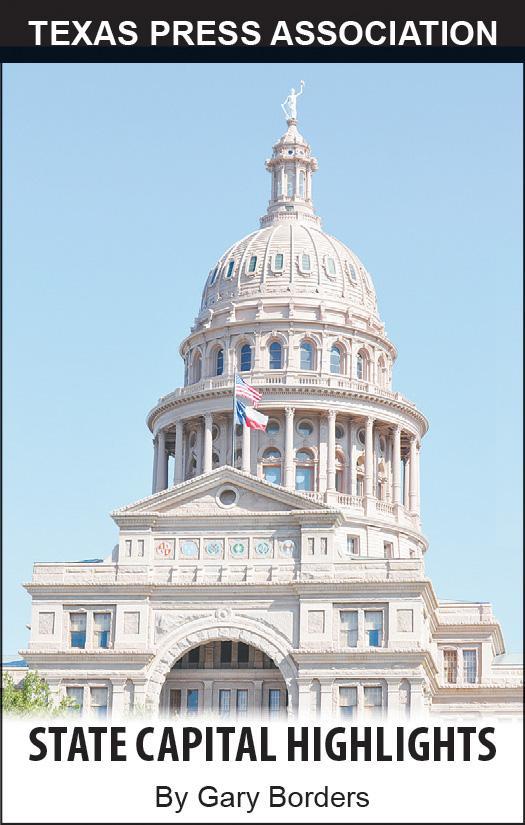
Texas Press Association
Capital Highlights — Eight proposed amendments on November ballot
The order has been drawn for eight proposed amendments to the much-amended Texas Constitution that will appear on the Nov. 2 ballot. The proposed amendments were approved by at least two thirds of both houses of the state Legislature. According to the Austin American-Statesman, they include:
• Allowing families to designate an “essential caregiver” to have access to loved ones in nursing homes and other long-term facilities. The issue came up when visitors were banned from such facilities during the pandemic.
• Banning all government entities — state, cities, counties, etc. — from limiting or preventing religious services, also an issue that arose during the pandemic.
• Providing property tax exemptions to spouses of soldiers killed in the line of duty.
• Barring attorneys whose law license has previously been suspended or revoked from serving as judges, and requiring district judges to be practicing lawyers for at least eight years. The minimum required now is four years.
• Allowing counties to issue bonds to finance transportation or other infrastructure projects in blighted or unproductive areas.
• Allowing the state’s professional rodeo associations to raise money through raffles, as other charities can do.
• Authorizing the State Commission on Judicial Conduct, which investigates complaints against judges, to also oversee the conduct of judicial candidates.
• Allowing school taxes to continue to be reduced for those 55 and older upon the death of a spouse with a disability.
As the Statesman reported, Texas voters to date have approved 507 amendments, making the Texas Constitution one of the longest in the nation.
Advice on trees recovering from Winter Storm Uri
As August arrives, landowners wondering about trees stricken during Winter Storm Uri in mid-February can quit wondering what to do about trees that are still completely bare: they are almost certainly not going to come back.
Specialists with the Texas A&M Forest Service, along with Neil Sperry, a widely known gardening and horticulture expert, teamed up last May to urge Texans to wait until mid-July before cutting down leafless trees. The vast majority of trees that were slow to leaf out have mostly recovered.
“The waiting was important, because we’re just now beginning to differentiate between those trees that are obviously not going to survive; those that are wounded and we hope will survive; and those that are definitely going to survive, but are going to take a little while to come back,” Sperry said,
Gretchen Riley, the Urban and Community Forestry Program Leader at Texas A&M Forest Service, said if a tree is bare and hasn’t put out a single leaf, it is almost certainly dead. This also applies to palm trees, which were especially hard hit by the storm.
“Anything green means that the tree has a chance for recovery,” Riley said. “But a single small frond should have grown and opened on palm trees by now. No green means it is dead and has already started rotting internally.”
She added that trees that lost much of their canopy may or may not survive. A good rule of thumb is imagining a circle around all a tree’s branches. A fourth of that circle should be filled in with leaves. If not, the tree is most likely doing to die, Riley said.
State reports first West Nile case
The state’s first case of illness caused by West Nile virus this year was reported in Dallas County, according to the Texas Department of State Health Services.
The virus is transmitted through bites from infected mosquitoes. While most people exposed to West Nile don’t get sick, about 20% develop symptoms such as headache, fever, joint and muscle aches, nausea and fatigue.
DSHS urges Texans venturing outdoors to wear long sleeves and pants and apply insect repellent. The agency also recommends removing standing water from tires, toys, buckets and other items.
Over the past five years, the state has had 805 cases of West Nile virus and 63 deaths.
TCEQ plans to use drones during disasters
The next time a hurricane or other natural disaster hits Texas, the Texas Commission on Environmental Quality plans to use drones to help staff survey land difficult for personnel to visit by foot or in a vehicle.
TCEQ now has 25 drones equipped to allow live-streaming video during disaster events. More than two dozen staff members have completed classroom instruction, with 17 having passed the FAA exam for what are formally called Unmanned Aerial Systems.
DSHS awards $10 million in grants for vaccine efforts
As COVID-19 vaccination rates lag and cases of the delta variant spike, DSHS will award $10 million to local groups working to promote vaccination efforts. The grants of $50,000 to $150,000 will go to a wide range of organizations providing vaccine education across the state.
A total of 6,251 lab-confirmed COVID-19 patients were in Texas hospitals as of Sunday, according to DSHS. That is quadruple the number reported a month ago and the most seen since February.
The Coronavirus Resource Center at Johns Hopkins University reported 62,722 new cases in Texas during the past week and 271 deaths — a five-fold increase from a month ago. A total of 12.67 million Texans are fully vaccinated — about 43% of the state’s population.
Gary Borders is a veteran award-winning Texas journalist. He published a number of community newspapers in Texas during a 30-year span, including in Longview, Fort Stockton, Nacogdoches and Cedar Park. Email: gborders@texaspress.com.











